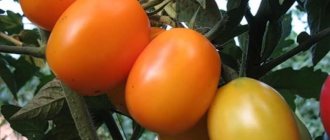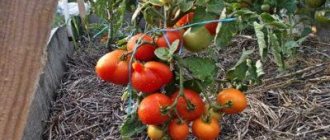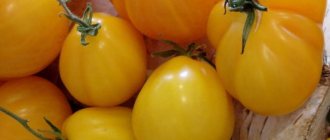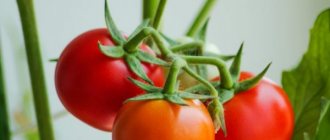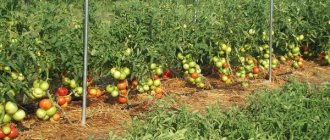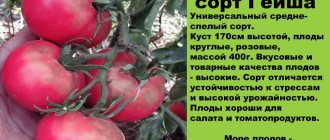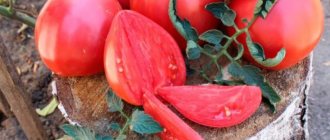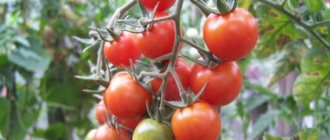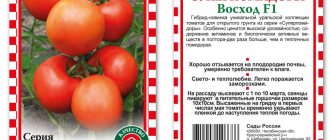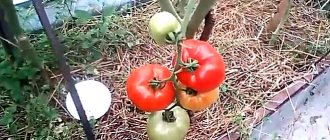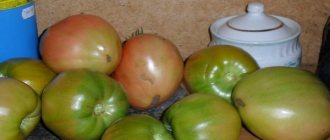Description of the variety
Tomatoes "Glacier" f1 are early-ripening plants - the fruits ripen 85-95 days from the moment the first shoots appear. The tomato bush is semi-determinate, standard type.
IMPORTANT: The plant bears fruit equally well both in greenhouses and in unprotected soil.
The height of the bush is 110-130 cm, the foliage is average. Tomatoes are resistant to major diseases and insect pests.
Description of the fruit of the variety:
- The average size;
- Round, slightly flattened shape;
- Ripe fruits have a rich bright red color;
- Number of seed chambers – 3-4 pieces;
- The dry matter content is about 5%;
- Good keeping quality;
- High taste qualities;
- Juiciness;
- Tomatoes can withstand transportation well over long distances;
- Weight 100-150 grams.
REFERENCE: First harvest tomatoes can weigh from 200 to 350 grams.
Planting in the ground and caring for tomatoes
By the time of transplantation to a permanent place at the age of 35-40 days, the seedlings reach 40 cm in height, have from 7 to 9 leaves and a powerful root system. By this time the soil should warm up to +15 C°.
Two weeks before this date, the seedlings begin to harden: the boxes are taken out into the fresh air, increasing the residence time every day.
In this way, the tomatoes gradually adapt to other conditions and do not experience severe stress during transplantation. Two days before transplanting, the plants are left outside overnight.
Before planting tomato bushes, the soil is saturated with nutrients. To do this, green manure is sown in early spring. Shortly before planting begins, they are dug up. Green manure accelerates the growth and expansion of green mass of tomatoes, making the land more fruitful. During digging, ash and nitrogen-containing fertilizers are added to the soil.
Next, prepare holes corresponding to the size of the seedlings. They are watered with water. The plants are carefully removed from the cups and placed in the holes. Cover the top with soil and water again.
Tomato Glacier needs shaping. The ovary is formed after the fifth internode. All foliage below the first ovary is gradually removed, leaving a small stump. This procedure will provide the ripening fruits with a sufficient amount of moisture and nutrients.
After pruning, to prevent fungal diseases, the plants are sprayed with Furacilin.
Tomatoes: advantages and disadvantages
Let us dwell on the main advantages of the tomato variety “Glacier” f1:
- High yield;
- Low temperature resistance;
- Early maturation;
- Excellent taste;
- Good presentation of the fruit.
Review of the most productive tomatoes in July:
Review variety tomatoes have some disadvantages:
- Capriciousness to the growing soil;
- The need for constant feeding of bushes.
a brief description of
- Where to grow: unprotected soil in the south, greenhouses in the rest of the Russian Federation
- Bush height, cm: 110–130
- Ripening time, days: 85–95
- Productivity, kg per 1 m2: up to 32
- Fruit weight, g: 100–150
- Application: industrial cultivation, universal use
- Advantages : cold and frost resistance,
- early ripening,
- very high yield,
- immunity to diseases and pests.
Growing tomatoes
The “Lednik” f1 variety is characterized by a seedling growing method. In order to obtain strong and healthy seedlings, a number of certain rules should be followed.
How to prepare seeds?
Basic recommendations for preparing seed material:
- Select whole, large seeds without visible deformations;
- Fill wide containers with pre-prepared soil;
- Treat the seeds with special growth stimulants.
Sowing seed material
Basic Rules:
- Sowing seeds to a depth of at least 1.5-2 cm;
- After planting, cover the future seedlings with thin glass or durable film;
- Perform regular watering;
REFERENCE: The soil for planting seeds must be fed with mineral fertilizers or organic matter.
- Do not forget to feed the planted seeds at least twice;
- Ensure a constant temperature in the room with seedlings.
After the first shoots appear, plants should be provided with constant artificial or natural lighting.
Rules for planting seedlings
A week before planting seedlings, it is recommended to harden them. To do this, containers with seedlings are taken outside into fresh air.
IMPORTANT: Hardening begins at 30 minutes and gradually increases the time the bushes stay outside to two hours.
When two permanent leaves appear, the seedling needs to be picked.
To obtain a high yield and better growth of Glacier tomatoes, f1 bush should be formed into 2 or 3 stems.
Bush care
The varietal tomato is unpretentious in care, so even a novice gardener or farmer can cope with its cultivation. To get a good result, it is recommended to follow a number of the following measures:
- Watering the plants with warm water in the morning or evening as needed;
- Regular weeding of beds to remove weeds;
IMPORTANT : You should beware of diseases that develop if the care regimen is not followed. To avoid the occurrence of these diseases, you need to regularly loosen the soil and not exceed the recommended watering rates.
- Loosening the soil under tomato bushes;
- Tying the stems;
- Establishing reliable support for the bush;
- Regular fertilizing using complex fertilizers.
Sowing and growing seedlings
In any climatic conditions, it is best to grow tomatoes in seedlings. This will require planting boxes of shallow depth. They are filled with fertile soil with a loose structure. As a rule, it consists of:
- ordinary turf or garden soil;
- clean sand;
- peat;
- humus;
- a small amount of ash.
The optimal acidity level for tomatoes is 5.5-6.5. To find out its level in the soil, indicator test strips are used. In case of large deviations, the acidity is adjusted to the recommended levels.
To grow seedlings, you can use ready-made soil. It has the necessary acidity and does not require preparation.
Glacier tomato seeds are sown in early March. To protect seedlings from viral diseases in the initial stages of growth and development, seed material is treated with potassium permanganate. For this procedure, you will need a glass of clean, settled water in which 1 gram of the drug is dissolved. The seeds are placed in a fabric bag and dipped in the prepared solution for 20 minutes.
The seedling boxes are filled with soil and watered with water that has settled at room temperature. Seeds are sown to a depth of no more than 2 cm and sprinkled with soil. The soil is moistened with warm water with the addition of the biostimulator Kornevin. Standard proportions for the first watering: 1 gram of the drug per liter of water.
To create a greenhouse effect, the seedlings are covered with film. The greenhouse is ventilated daily.
Fruitful cultivation of seeds is possible at a stable temperature of at least +21 C°. As soon as the first shoots appear on the surface of the earth, the film is removed.
Seedlings are planted at the stage of 2-3 leaves into separate containers.
Diseases and pests
The “Glacier” f1 variety is distinguished by very high immunity to most diseases. In rare cases, the plant may become infected with root rot. This disease is fought in the following ways:
- Loosening the soil;
- Mulching beds;
- Reducing watering the land.
If tomatoes are grown in greenhouses, ventilation measures should be taken.
Variety "Glacier" f1 can be attacked by the following insect pests:
- Melon aphid;
- Colorado beetle;
- Thrips;
- Garden cutworm;
- Greenhouse whitefly.
Pest control methods are divided into chemical and biological. The following drugs are used to kill insects:
- Bison;
- Prestige;
- Confidor.
Biological control methods include:
- Regular weed removal;
- Collection of Colorado potato beetle larvae and adults by hand.
Description and general characteristics of the Glacier tomato variety, yield and frost resistance
The Glacier tomato is resistant to low temperatures and has a fairly high yield. It is grown outdoors until the end of the summer season. Glacier tomato fruits can be eaten fresh or canned whole. These tomatoes produce high-quality tomato juice and good paste.
The variety was bred by Siberian breeders for the conditions of the North. The first samples were obtained in 1999, and the state registration of this tomato variety for open ground was carried out in 2000.
Brief description of the plant
Characteristics and description of tomato Glacier f1:
- early variety;
- from the moment of planting seedlings to the appearance of fruits, it takes from 80 to 100 days;
- the plant grows well in open, unprotected soils, but it can also be grown in greenhouses;
- the entire group of tomatoes included in the glacier variety (Sadovaya Zhemchuzhina, Tarpan and others) is characterized by high yield;
- after ripening, the fruits of the described plant acquire a bright red color;
- The shape of the fruits of this variety is round, slightly flattened on the sides;
- the average weight of each fruit is 0.1-0.15 kg, although if you carry out the first harvest after the tomato ripens, most specimens will have an average size with a weight of up to 0.2-0.3 kg;
- the collected fruits can be stored for a long time;
- withstand long-term transportation.
Tomatoes of the Glacier variety grow well in the southern regions of Russia and in the central zone of the country. Gardeners growing this variety in the northern regions are advised to cover plants growing in open ground with film, and in the Far North it is best to grow Glacier in well-heated greenhouses.
If all agrotechnical measures are carried out correctly, you can get 7-8 kg of tomatoes from each bush, and if you use the nest planting method (4 bushes/1 sq. m of bed), you can harvest up to 30 kg of crop.
Reviews about Glacier type tomatoes are positive, but along with the advantages, gardeners also note the disadvantages of this variety. Farmers write about the high immunity of tomatoes to various diseases, the ability to withstand sudden drops in temperature and the good taste of the fruit. But gardeners note that Glacier-type bushes are demanding in terms of soil composition and the need for intensive feeding during their growth stage.
Productivity
A distinctive feature of “Glacier” f1 is its excellent yield. From one adult bush you can harvest 8 kg of tomatoes. If the recommended planting density is observed, about 32 kg of tomatoes are harvested from 1 square meter. This is an absolute record among medium-sized tomatoes.
Which regions are best to grow in?
In open ground gardens, tomatoes grow well in the southern regions and in the middle zone. In the northern regions, it is recommended to grow tomatoes under film, and in the far north - in heated greenhouses.
Severe northerner: characteristics and description of the tomato variety Glacier
Tomatoes Glacier f1 received this name for a reason - they are able to tolerate low temperatures and bear fruit well in open ground. In addition, they have excellent yield and pleasant taste.
| Height | Landing location | Ripening time | Fruit color | Fruit size | Origin | Fruit shape |
| Medium height | Greenhouse, Open ground | Early ripening | Reds | Average | Hybrid | Round |
Features of the variety
Of course, it should be noted that the Glacier tomato has its own characteristics. Let's look at them in more detail and find out what distinguishes this type of tomato from other types.
- Harmonious ripening of tomatoes.
- Immunity to many diseases that are inherent in nightshades.
- Tomatoes have a bright red color when they are fully ripe.
- The fruit is round in shape, which is classic for many varieties of tomatoes. When ripe, it is not small and weighs about 350 grams, which is considered larger than average. The tomato itself is smooth and even.
- The Glacier variety is very aromatic and sweet, suitable for use in any form.
- The amount of dry matter in one tomato does not exceed 5 percent.
This variety will be an excellent solution for those who want to get a good harvest, so it is worth planting it in your garden, especially if you are in the northern region. The fruits can be stored for a long time and easily transported, as it is resistant to transportation.
tomato Snubnosik - description and characteristics of the variety
Popular varieties of tomatoes
Most gardeners know which varieties of crops to plant and which ones should not be planted, but the desire for experiments and new discoveries pushes them to purchase unfamiliar plants. Thanks to the general experience of gardeners, as well as sales statistics of certain varieties, the most popular types of garden plants have appeared. There are similar statistics among tomatoes.
Varieties with red fruits
The most popular type of tomato is red. Even novice gardeners are familiar with them; more than one generation of summer residents have been growing them. Among these garden regulars there are varieties both for greenhouses and for open ground:
- Miracle of the Earth . Characterized as the most excellent variety by both gardeners and breeders. The fruits have a fleshy texture, do not crack, and are perfectly stored. You should expect an average yield from the variety, about a bucket of fruits per bush. It reaches a height of up to 1.5 meters. The main problem is the presence of many fakes, so it is better to purchase seeds from trusted suppliers.
- Gina . Mid-season variety, berries are quite large in size from 150 to 250 grams. The bushes themselves are low, reaching 0.8 meters, and do not require tying or shaping. Tomatoes grow in a round, even shape and have dense flesh and skin, which allows them to be stored for a very long time. The species has amazing productivity, up to 10 kg from 3 bushes.
- Appetizing . Bushes up to 1 meter tall. The harvest is large, up to 350 grams, ribbed, and has a rich sugar taste. The pulp of the fruit is distinguished by its density and contains a lot of juice. It is especially popular among residents of the middle zone.
- Bull's heart . It gained its popularity a long time ago for its amazing yield: the average weight of the fruit is about half a kilogram, and cultivation does not require much effort. The bushes grow about 1.7 m in height, and therefore require support or garters. From one such plant you can get about 2 large buckets of tomatoes. Miracle of the earth Gina Appetizing Bull's heart Sweet bunch Nevsky De barao
- Sweet bunch . The name speaks for itself, the harvest is very sweet, collected from clusters - up to 40 small specimens from one branch. The species demonstrates excellent resistance to all kinds of diseases and, given the size of the fruits of 40 grams, a fairly high yield.
- Nevsky . The ultra-early variety, due to its growth, does not require garters, supports or formations. The ovary bears up to 5 perfectly round tomatoes, 60 grams each. Since it ripens very early, it is virtually not susceptible to disease. It gained popularity for its unpretentiousness and productivity.
- De Barao . One of the most common mid-season varieties of red tomatoes. Individual specimens can reach 2 m. In general, the yield from one plant is around 3.5 kg. The variety is quite resistant to diseases and pests, but due to its growth it requires a lot of attention in care.
Yellow color
Yellow tomatoes are considered truly exotic, despite this, and among them there are leaders in popularity for their high qualities and performance.
These species acquire their color due to the rich content of provitamin A, which provides invaluable support in the fight against cancer of the genitourinary system.
By the way, another great advantage of yellow tomatoes over red ones is their low calorie content.
- Golden heart . An early-ripening species, which is a strong, low bush, only about 35 cm. Each cluster can bear from 5 to 7 heart-shaped fruits. When ripe they have a spectacular golden-fiery color.
- Golden gem F1 . A variety of medium ripeness. A simple cluster produces 5 to 10 fruits with an average weight of 55 grams. Resistant to diseases and pests. The berries are versatile and have an excellent taste, both in salads and canned.
- Dina . A medium-early low plant, reaching 50-75 centimeters in length. Despite this, the fruits are quite large; the weight of individual specimens can reach 300 grams. The berries are very tasty with a pleasant orange color. Golden Heart Golden Gem F1 Dina Wonder of the World Radunitsa Sweet Donut Yellow Giant
- Wonder of the world . Specimens with unlimited growth reach a height of 3 m. One plant can produce up to 12 kg of tomatoes per season. The fruits are very smooth and resemble lemons in appearance.
- Radunitsa . The plant is mid-season, reaches a height of 1.5 m. The fruits are quite large, look very similar to pears, and have a unique sweetish taste. The variety is universal, suitable for both greenhouses and open ground.
- Sweet donut . Mid-season species, grows up to 1 meter. Bears medium-sized round fruits. It is considered quite productive and versatile in cultivation.
- Yellow giant . One of the largest yellow tomatoes. The average weight of its fruits is 200-250 grams; the plant is classified as mid-season and exhibits the highest performance when grown in a greenhouse.
The best tomatoes for open ground
All of the above types of tomatoes have their own unique properties, but not all of them are suitable for planting in open ground. Without care and attention, any plant will die; outdoor varieties are no exception; their main feature is resistance to cold snaps, which especially often occur in early spring.
Betalux Alpha Pani Yana Slavyanin
- Sweet donut;
- Radunitsa;
- Slav;
- Mrs. Yana;
- Alpha;
- Betalux;
- Gina.
These and many other varieties perform well in conditions of even prolonged frosts, and with due respect and attention, they will delight you and your loved ones with an unprecedented harvest.
Popular for the Moscow region
The Moscow region, by its geographical affiliation, belongs to central Russia, therefore the varieties need to be selected accordingly. Frost-resistant species for planting in open ground feel great here. They tolerate sudden frosts well and, with proper care, produce a wonderful harvest.
Breeders do not stand still in their experiments, so for a long time there have been varieties that differ not only in climatic characteristics, but also those that are suitable for a particular soil.
The following representatives of tomatoes are becoming increasingly popular in the Moscow region:
White filling Sultan F1 Fitous
- White filling . The most magnificent early low-growing variety. Feels great both in greenhouse conditions and outdoors.
- Sultan F. The tomato is of Dutch origin, but oddly enough, it feels great on the plots of gardeners near Moscow.
- Fitous . An excellent mid-early variety for central Russia. The first harvest can already be harvested 3-3.5 months after planting.
Most disease resistant
As a rule, the most stable and disease-free plant will be the one that is regularly cared for and protected from diseases in every possible way. Only increased attention will ensure maximum health for a particular tomato.
Bull heart red
Thanks to breeders, there are also tomatoes that are very unpretentious, and even in the absence of regular care from the gardener, these representatives of garden crops feel great and perfectly resist all sorts of diseases on their own.
- Miracle of the Earth;
- Bull's Heart;
- Sweet bunch;
- Nevsky;
- Slav;
- Golden heart;
- Radunitsa;
- Yellow giant.
These varieties are the most unpretentious, and even left to the mercy of fate, they continue to delight with an unprecedented harvest.
Best early
The popularity of early varieties is due to the problematic nature of farming associated with the peculiarities of the Russian climate.
Early and ultra-early varieties include those tomatoes that produce their first harvest earlier than 100 days after sowing; among them are:
- Golden heart;
- Nevsky;
- Explosion;
- Gina;
- Alpha.
These are some of the most popular selections with early yields, but by no means all of them.
0.00, (ratings: 0) Loading…
Source: https://gardenaddict.ru/ogorod/ovoshhi/luchshie-sorta-tomata.html
Recommendations for cultivation
Although the Glacier tomato variety is unpretentious, there are still a number of recommendations that should be followed in order to get an excellent harvest. Let's look at these recommendations below.
- It is recommended to germinate seeds using seedlings. It is advisable to plant them a month before planting in the ground, during which time they will have time to grow. The best time to plant seedlings is mid-March.
- Before planting seeds, they need to be properly prepared. To do this, they need to be taken outside for 1-2 weeks, gradually increasing the time, starting from 30 minutes and reaching up to 2 hours. This way the seeds will be optimally ready for planting, and you can be sure that they will not freeze and will not be affected by weather conditions.
- Sowing of seeds is carried out according to the recommendations of specialists at a depth of 1.5-2 cm.
- It is important to take care to maintain a constant temperature in the room - it should not be lower than 21 degrees.
- As soon as 2 true leaves appear, a pick should be made.
In order to get an excellent harvest, you must follow several rules during the growth of tomatoes.
- The bushes need to be watered, but this should be done only as needed. You can water tomatoes either in the morning or in the evening - this is a very important rule. Only warm water is suitable for irrigation.
- The land must be fertilized - this way the tomatoes will receive all the necessary elements and minerals, and as a result you will have an excellent harvest.
- It is also necessary to loosen the soil as necessary and tie up the stems.
Main characteristics
The Glacier tomato is in particular demand in the northern regions, because it is very problematic to grow another variety of tomatoes here.
Let's consider the main characteristics of this variety. So, it adapts even to cold conditions and is able to produce crops. The harvest of this variety is quite large, and on average you can get up to 8 kg of fruit from one bush - this is a good result. The plant belongs to the semi-determinate type, the bush is standard, requires feeding, especially in cold regions.
The foliage is average. This is an early ripening variety - the fruits appear no later than 95 days after planting.
tomato Azure giant - description and characteristics of the variety
Tomatoes of the Glacier f1 variety are designed specifically for growing in areas with a temperate or cold climate. The variety is popular among gardeners and is widely distributed in summer cottages. The main positive features of tomatoes include high yield and resistance to temperature changes.
The variety was bred by Siberian breeding scientists in 1999. The main purpose of the variety is cultivation in cold regions.
Tomato was included in the State Register of the Russian Federation in 2000 as a plant for growing in open ground and greenhouses.
Description of the variety
Tomatoes "Glacier" f1 are early-ripening plants - the fruits ripen 85-95 days from the moment the first shoots appear. The tomato bush is semi-determinate, standard type.
The height of the bush is 110-130 cm, the foliage is average. Tomatoes are resistant to major diseases and insect pests.
Description of the fruit of the variety:
- The average size;
- Round, slightly flattened shape;
- Ripe fruits have a rich bright red color;
- Number of seed chambers – 3-4 pieces;
- The dry matter content is about 5%;
- Good keeping quality;
- High taste qualities;
- Juiciness;
- Tomatoes can withstand transportation well over long distances;
- Weight 100-150 grams.
Let us dwell on the main advantages of the tomato variety “Glacier” f1:
- High yield;
- Low temperature resistance;
- Early maturation;
- Excellent taste;
- Good presentation of the fruit.
Review variety tomatoes have some disadvantages:
- Capriciousness to the growing soil;
- The need for constant feeding of bushes.
Application of fruits
Ripe tomatoes are widely used fresh. The fruits tolerate heat treatment well. Tomatoes are ideal for canning or pickling in their entirety. Also, from tomatoes of the Glacier f1 variety we obtain high-quality juices, sauces, ketchups, and purees.
The “Lednik” f1 variety is characterized by a seedling growing method. In order to obtain strong and healthy seedlings, a number of certain rules should be followed.
Basic recommendations for preparing seed material:
- Select whole, large seeds without visible deformations;
- Fill wide containers with pre-prepared soil;
- Treat the seeds with special growth stimulants.
Basic Rules:
- Sowing seeds to a depth of at least 1.5-2 cm;
- After planting, cover the future seedlings with thin glass or durable film;
- Perform regular watering;
- Do not forget to feed the planted seeds at least twice;
- Ensure a constant temperature in the room with seedlings.
After the first shoots appear, plants should be provided with constant artificial or natural lighting.
A week before planting seedlings, it is recommended to harden them. To do this, containers with seedlings are taken outside into fresh air.
When two permanent leaves appear, the seedling needs to be picked.
To obtain a high yield and better growth of Glacier tomatoes, f1 bush should be formed into 2 or 3 stems.
Bush care
The varietal tomato is unpretentious in care, so even a novice gardener or farmer can cope with its cultivation. To get a good result, it is recommended to follow a number of the following measures:
- Watering the plants with warm water in the morning or evening as needed;
- Regular weeding of beds to remove weeds;
- Loosening the soil under tomato bushes;
- Tying the stems;
- Establishing reliable support for the bush;
- Regular fertilizing using complex fertilizers.
Diseases and pests
The “Glacier” f1 variety is distinguished by very high immunity to most diseases. In rare cases, the plant may become infected with root rot. This disease is fought in the following ways:
- Loosening the soil;
- Mulching beds;
- Reducing watering the land.
If tomatoes are grown in greenhouses, ventilation measures should be taken.
Variety "Glacier" f1 can be attacked by the following insect pests:
- Melon aphid;
- Colorado beetle;
- Thrips;
- Garden cutworm;
- Greenhouse whitefly.
Biological control methods include:
- Regular weed removal;
- Collection of Colorado potato beetle larvae and adults by hand.
Productivity
A distinctive feature of “Glacier” f1 is its excellent yield. From one adult bush you can harvest 8 kg of tomatoes. If the recommended planting density is observed, about 32 kg of tomatoes are harvested from 1 square meter. This is an absolute record among medium-sized tomatoes.
READ MORE: Tomato Tyler - description and characteristics of the variety
In open ground gardens, tomatoes grow well in the southern regions and in the middle zone. In the northern regions, it is recommended to grow tomatoes under film, and in the far north - in heated greenhouses.
Reviews about the variety
Tomatoes "Glacier" f1 are widely used in summer cottages and gardens due to their unpretentiousness, resistance to temperature changes and a large number of infections and fungal diseases. Gardeners speak of the variety as a tasty, juicy and beautiful tomato.
Today, the tomato is one of the most common plants in the beds of vegetable growers in the northern and southern regions of Russia. The Glacier tomato successfully bears fruit even in the coldest corners of the country. In 1999, Siberian breeders developed this cold-resistant variety. In 2000, it was officially included in the state register.
general information
The tomato bears fruit consistently in greenhouse conditions and in open ground. Characteristics and description of the variety:
- semi-determinate;
- high yield, up to 8 kilograms of berries are obtained from one bush during the summer season;
- early ripening, maximum period before fruit appearance is 95 days;
- standard;
- plant height does not exceed 130 cm;
- average foliage of the bush;
- resistant to low temperatures;
- friendly ripening of fruits;
- resistant to most diseases of the nightshade family;
- unpretentious;
- long-term storage and transportation possible;
- demands on fertilizing and soil composition.
The popularity of the variety is due to its resistance to low temperatures. The name of the tomato is justified; tomatoes feel equally good in the open ground of the northern and southern regions. Appearance and technical data of the fruits of the Glacier variety:
- mature color: bright red;
- round, slightly flattened shape;
- medium size, with a maximum tomato weight of no more than 350 grams;
- 3-4 cameras;
- the amount of dry matter does not exceed 5%;
- smooth;
- sweet taste;
- fragrant.
Tomatoes are among the versatile ones. Ripe berries are used for canning, pickling, making ketchups, purees, pastes, and juice. In its raw form, the tomato is suitable as an ingredient for vegetable salads and table decoration.
For the variety, the seedling method of planting is preferable. Preparatory work begins a month before the expected sowing date, usually mid-March. To obtain healthy seedlings, it is recommended to follow a number of rules:
- prepare containers with soil;
- sowing tomato seeds to a depth of 1.5-2 cm;
- after sowing, cover the seedlings with films;
- will ensure a constant room temperature of at least 21 degrees;
- carry out regular watering;
- feeding seedlings at least twice;
- after emergence, provide the plants with a constant source of artificial or natural light.
7-10 days before planting, hardening of tomato seedlings begins. Take the bush out into the fresh air. The hardening time starts at 30 minutes and is increased to 2 hours. When two true leaves appear, picking is necessary.
IMPORTANT! To get the best harvest, it is recommended to form a bush with 2-3 stems.
The tomato is not fussy to care for; a novice gardener can handle the cultivation. To get the best result, you should follow a set of measures:
- watering with warm water in the evening or morning hours, as needed;
- regular loosening and weeding;
- feeding with complex mineral fertilizer;
- tying stems and establishing support.
Gardeners' opinion
Good day! Neighbors at their summer cottage recommended the Glacier tomato variety. I have never seen this type before. Survived the cool summer in St. Petersburg very well. Productivity exceeded expectations. From 1 sq. meters of planting, 28 kilograms of berries were collected. Resistance to low temperatures, unpretentiousness and good taste have brought the tomato to first place. Next summer I plan to create 4 beds. Ripe berries are suitable for canning and pickling for the winter. I recommend!
Anastasia Valeryanovna, 54 years old
I advise all residents of northern Russia to buy Glacier tomato seeds. It can withstand low temperatures, bears fruit consistently and does not require special care. It is important to tie up the bushes and install support, otherwise you won’t get a good harvest. The variety is not demanding in terms of care and withstands most diseases. Ripe tomatoes are very sweet and juicy. They tolerate transportation well and are stored for a long time; you can pamper yourself with fresh berries until mid-October. I didn’t find any cons for myself.
